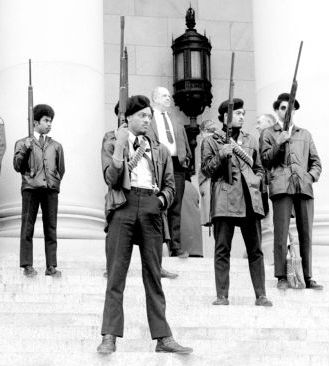(Sostaita)
Organizations like the NAACP and SNCC
fought for African American rights, but they did so peacefully.
After decades without attaining true equality many Blacks were tired
of the NAACP's efforts. “The Black Panther Party came into
existence, not to support or supplement the major civil rights
organizations, but to supplant them.”(Abu-Jamal 66) The daring
actions of the Black Panther Party attracted many dispirited African
Americans. One writes that he, “with a mixture of disbelief and
mounting excitement, read the front-page story about a group of some
thirty armed lacks calling themselves the Black Panther Party for
Self-Defense. Led by their chairman, Bobby Seale, they had invaded
the state capitol at Sacramento to protest a proposed gun bill
designed to limit a person's right to carry firearms. Only the women
members of the group were unarmed. The men carried everything from
.38 pistols to shotguns...I was proud that they had armed themselves
and faced down the enemy on his own ground...these young people were
making history.” (Brent 87) For more information on the Sacramento
protest, click here.
("Seattle Black Panther Party")
The Black Panthers created a 10-Point Platform that laid out their desires for equal rights.
(Revolutionary Warfair)
The full text of the plan can be read
here.
Most Panthers' lives “were dedicated to community service. That mean long, sustained work to keep our community programs running”. (Abu-Jamal 70) These community programs included clinics to treat Blacks, as well as programs to offer free clothing to African Americans who needed it. Programs were organized by the Panthers, and varied from city to city in what they offered. The most prevalent and popular was the Free Breakfast for Children Program, which offered decent, filling meals to kids in need.
Community service “also meant battling the State when it came at us.” (Abu-Jamal 70) Part of this battle lay in the Police-Alert Program. “...one of the Party's first programs was the Police–alert Patrols, where members trailed cop cars in the Black neighborhood, armed with guns, tape recorders, cameras, and law books...this program had very serious risks, given the nature of the police.” (Abu-Jamal 67) This program proved immensely popular with the Black community, and could be found in most chapters of the Black Panther Party. “The Police Patrols had become an integral part of BPP community policy. Members of the BPP would listen to police calls on a short wave radio, rush to the scene of the arrest with law books in hand and inform the person being arrested of their constitutional rights.” ("State Capitol March”)
(Meyer)
Unfortunately, this party was not to last. Internal conflicts led to many members splitting off, and clashes with the United States government led to several members being arrested or fleeing the country. “By the beginning of the 1980s, attacks on the party and internal degradation and divisions, cause the party to fall apart. The leadership of the party had been absolutely smashed; its rank and file constantly terrorized by the police. Many remaining Panthers were hunted down and killed in the following years, imprisoned on trumped charges (Mumia Abu-Jamal, Sundiata Acoli, among many others), or forced to flee the United States (Assata Shakur, and others).”(Baggins)
Despite their disintegration, the Black Panther Society was at least in part a success. Their efforts for civil rights, along with those of other groups such as SNCC and NAACP, led the the gain of many civil liberties for African Americans in the US. While not all of the points of the 10-Point Platform were granted, several were: the majority of Blacks now have access to land, bread, housing, education, and clothing. However, cases like those of Trayvon Martin and the “Black Lives Matter” movement continue to call into question whether or not Blacks have one of the most important points pushed for by the Black Panther Party – justice.
Works Cited
“10-Point
Plantform.” A Huey P. Newton Story. PBS
2002. Web. December 4, 2015.
<https://www.pbs.org/hueypnewton/actions/actions_platform.html>
Abu-Jamal, Mumia. We Want Freedom: A Life in the Black Panther Party. Massachusetts: South End Press, 2004. Print.
Baggins, Brian. History of the Black Panther Party. Marxists Internet Archive (marx.org), 2002. Web. December 4, 2015. < https://www.marxists.org/history/usa/workers/black-panthers/>
Brent, William Lee. Long Time Gone: A Black Panther's True-Life Story of His Hijacking and Twenty- Five Years in Cuba. New York: Times Books and Toronto: Random House, 1996. Print.
“May 2, 1967, Sacramento, CA:.” The Black Panther: Black Community News Service. Virginia.edu. Web. December 4, 2015. < http://xroads.virginia.edu/~ug01/barillari/pantherprologue.html>
Meyer, Matt. “Panthers, pacifists, and the question of self-defense.” Waging Nonviolence: People-Powered News and Analysis. May 10, 2012. Web. December 4, 2015.
<http://wagingnonviolence.org/feature/panthers-pacifists-and-the-question-of-self-defense/>
Revolutionary Warfair. “Bobby Seale The Black Panther s Ten Point Program www keepvid com”. Video. YouTube. Sep 6, 2010. Web. December 4, 2015. <https://www.youtube.com/watch?v=1EZ3qS4vTYs>
“Seattle Black Panther Party History
and Memory Project.” Seattle Civil Rights and & History
Project. 2004. Web. December
4, 2015. < http://depts.washington.edu/civilr/BPP.html>
Sostaita, Barbara. “The Black
Panther Party Revisited.” Students for Liberty: A Free Academy,
A Free Society. Feb 10, 2014.
Web. December 4, 2015.
<http://studentsforliberty.org/blog/2014/02/10/the-black-panther-party-revisited/>
“State
Capitol March.” A Huey P. Newton Story. PBS
2002. Web. December 4, 2015.
<http://www.pbs.org/hueypnewton/actions/actions_capitolmarch.html>


